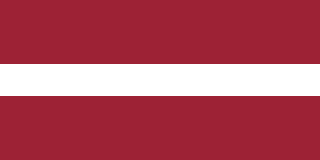Latvia - Geography

Here, let us take a look at the Geography of Latvia. Most of the country is composed of fertile low-lying plains with some hills in the east. Mother's mean age at first birth is 27.3 years (2020 est.) (), whereas, the Maternal mortality ratio is 19 deaths/100,000 live births (2023 est.)
Geographical data of Latvia
| Location | Eastern Europe, bordering the Baltic Sea, between Estonia and Lithuania |
|---|---|
| Geographic coordinates | 57 00 N, 25 00 E |
| Map references | Europe |
| Tarrain | low plain |
| Natural Resources | peat, limestone, dolomite, amber, hydropower, timber, arable land |
| Natural Hazards | large percentage of agricultural fields can become waterlogged and require drainage |
| Irrigated Land | 6 sq km (2016) |
| Major rivers (by length in km) | |
| Major aquifers | |
| Land Boundaries | 1,370 km |
| Border Countries | Belarus 161 km; Estonia 333 km; Lithuania 544 km; Russia 332 km |
| Coastline | 498 km |
| Climate | maritime; wet, moderate winters |
| Area | |
| Total Area | |
| Land Area | 62,249 sq km |
| Water Area | 2,340 sq km |
| comparative Area | slightly larger than West Virginia |
| Maritime Claims | |
| Territorial sea | 12 nm |
| Exclusive economic zone | limits as agreed to by Estonia, Finland, Latvia, Sweden, and Russia |
| Continental shelf | 200 m depth or to the depth of exploitation |
| Elevations | |
| Highest point | Gaizina Kalns 312 m |
| Lowest point | Baltic Sea 0 m |
| Mean elevation | 87 m |
| Land Use | |
| Agricultural land | 31.7% (2022 est.) |
| Agricultural land: arable land | arable land: 21.8% (2022 est.) |
| Agricultural land: permanent crops | permanent crops: 0.2% (2022 est.) |
| Agricultural land: permanent pasture | permanent pasture: 9.7% (2022 est.) |
| Forest | 54.9% (2022 est.) |
| Other | 13.4% (2022 est.) |
Population Distribution
Largest concentration of people is found in and around the port and capital city of Riga; small agglomerations are scattered throughout the country
People and Society
In Latvia, the different Ethnic groups are such that we have: Latvian 62.7%, Russian 24.5%, Belarusian 3.1%, Ukrainian 2.2%, Polish 2%, Lithuanian 1.1%, other 1.8%, unspecified 2.6% (2021 est.)
| Population | |
|---|---|
| Pop growth rate | -1.14% (2024 est.) |
| Birth rate | 8.3 births/1,000 population (2024 est.) |
| Death rate | 14.7 deaths/1,000 population (2024 est.) |
| Health expenditure | |
| Physicians Density | |
| Hospital bed Density | 5.3 beds/1,000 population (2020 est.) |
| Total fertility rate | 1.55 children born/woman (2024 est.) |
| Gross reproduction rate | 0.76 (2024 est.) |
| Contraceptive prevalence rate | |
| Est married women (ages 15-49) | 49.1% (2023 est.) |
| Literacy | |
| Education expenditures | |
| Net Migration rate | -4.9 migrant(s)/1,000 population (2024 est.) |
| Nationality | Latvian | Latvian(s) |
| Languages | |
| Religions | Lutheran 36.2%, Roman Catholic 19.5%, Orthodox 19.1%, other Christian 1.6%, other 0.1%, unspecified/none 23.5% (2017 est.) |
| Age Structure | |
| 0-14 years | 14.7% (male 136,482/female 128,492) |
| 15-64 years | 63% (male 562,754/female 572,850) |
| 65 years and over | 22.2% (2024 est.) (male 137,746/female 262,922) |
| Dependency Ratios | |
| Total dependency ratio | 55.6 (2024 est.) |
| Youth dependency ratio | 23.5 (2024 est.) |
| Elderly dependency ratio | 32.1 (2024 est.) |
| Potential support ratio | 3.1 (2024 est.) |
| Median Age | |
| Total | 45.5 years (2024 est.) |
| Male | 41.6 years |
| Female | 49.2 years |
| Urbanization | |
| Urban population | 68.7% of total population (2023) |
| Rate of urbanization | -0.68% annual rate of change (2020-25 est.) |
| Major urban areas (Pop) | 621,000 RIGA (capital) (2023). |
| Sex Ratio | |
| At birth | 1.05 male(s)/female |
| 0-14 years | 1.06 male(s)/female |
| 15-64 years | 0.98 male(s)/female |
| 65 years and over | 0.52 male(s)/female |
| Total population | 0.87 male(s)/female (2024 est.) |
| Infant Motality | |
| Total | 4.7 deaths/1,000 live births (2024 est.) |
| Male | 5.1 deaths/1,000 live births |
| Female | 4.3 deaths/1,000 live births |
| Life Expectancy at birth | |
| Total population | 76.4 years (2024 est.) |
| Male | 72 years |
| Female | 81 years |
| Drinking Water Sources | |
| Improved: urban | urban: 98.9% of population (2022 est.) |
| Improved: rural | rural: 98.9% of population (2022 est.) |
| Improved: total | total: 98.9% of population (2022 est.) |
| Unimproved: urban | urban: 1.1% of population (2022 est.) |
| Unimproved: rural | rural: 1.1% of population (2022 est.) |
| Unimproved: total | total: 1.1% of population (2022 est.) |
| Alcohol consumption per capita | |
| Total | 12.9 liters of pure alcohol (2019 est.) |
| Beer | 4.9 liters of pure alcohol (2019 est.) |
| Wine | 1.7 liters of pure alcohol (2019 est.) |
| Spirits | 5.3 liters of pure alcohol (2019 est.) |
| Other alcohols | 1 liters of pure alcohol (2019 est.) |
| Tobacco use | |
| Total | 28.8% (2025 est.) |
| Male | 43.5% (2025 est.) |
| Female | 16.4% (2025 est.) |
Demographic profile
All Important Facts about Latvia
Want to know more about Latvia? Check all different factbooks for Latvia below.









